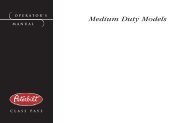MODEL 330 OPERATOR'S MANUAL - Peterbilt Motors Company
MODEL 330 OPERATOR'S MANUAL - Peterbilt Motors Company
MODEL 330 OPERATOR'S MANUAL - Peterbilt Motors Company
You also want an ePaper? Increase the reach of your titles
YUMPU automatically turns print PDFs into web optimized ePapers that Google loves.
Preventive Maintenance<br />
NOTE: Avoid using a hydrometer for measuring<br />
freeze point. Hydrometers have poor accuracy. Use<br />
a Glycol Refractometer for checking antifreeze protection.<br />
A 50/50 mixture (50% water and 50% low silicate antifreeze)<br />
is best for year-round normal operation. This will normally<br />
protect your engine from freezing and boil-over.<br />
Table 8<br />
Antifreeze Protection — Ethylene Glycol<br />
ETHYLENE GLYCOL ANTI-<br />
FREEZE % by VOLUME<br />
TEMPERATURE<br />
PROTECTION<br />
° C ° F<br />
0 O 32<br />
10 –4 24<br />
20 –9 16<br />
30 –15 4<br />
40 –24 –12<br />
50 –36 –34<br />
60 –47 –63<br />
68 –68 –92<br />
70 –65 –85<br />
80 –49 –57<br />
90 –35 –31<br />
100 –16 4<br />
Cooling System<br />
Always use low silicate antifreeze with water. Premix the<br />
coolant to maintain the correct proportion of antifreeze and<br />
water. This will ensure the right mixture of coolant conditioner<br />
chemicals. Install only enough low silicate antifreeze to provide<br />
the required protection against freezing.<br />
NOTE: If Long Life Coolant (LLC) antifreeze is used,<br />
recharge at 150,000 miles/241,000 km.; replace at<br />
300,000 miles/483,000 km.<br />
• Be sure different types of coolant are not mixed. Stay<br />
with the same coolant until a complete Replacement is<br />
performed.<br />
CAUTION: Never install 100% antifreeze for topup<br />
coolant. It could damage your vehicle. The<br />
maximum efficient Low Silicate Ethylene Glycol<br />
antifreeze concentration for extended low temperature<br />
operation is 68% glycol by volume.<br />
Exceeding this 68% limit reduces freeze protection.<br />
In an emergency, if the radiator becomes filled with water<br />
known to contain gypsum, sulfur, or chlorine, follow the below<br />
procedure:<br />
• Drain the cooling system as soon as possible<br />
• Flush the system<br />
Model <strong>330</strong> PB1318 3/01 – 149 –
















